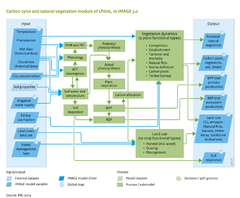Carbon cycle and natural vegetation
Parts of Carbon cycle and natural vegetation
| Component is implemented in: |
|
| Related IMAGE components |
| Models/Databases |
| Key publications |
| References |
Key policy issues
- What is the role of the terrestrial biosphere in the global carbon cycle, how will it change in time as a result of climate and land-use change?
- To what extent can the terrestrial biosphere contribute to reducing the accumulation of CO2 in the atmosphere and what are viable mechanisms?
- What opportunities exist to reduce land-use related carbon emissions (e.g. REDD) and even enhance the carbon uptake through the establishment of new forests.
- What are the contributions of land-use change, climate change and CO2 fertilization on the future carbon cycle and how can these be considered in climate policies?
Introduction
The terrestrial biosphere plays a key role in global and regional carbon cycles and thus in the climate system. Large amounts of carbon (between 2000 and 3000 PgC) are stored in the vegetation and soil components. Currently, the terrestrial biosphere absorbs about 30% of emitted CO2 (Ballantyne et al., 2012), and this carbon sink can be maintained and even enhanced by, for instance, protecting established forests and by establishing new forests (Doelman et al., 2019). However, deforestation and other land use changes in the last few centuries have contributed considerably to the build-up of atmospheric carbon dioxide (Friedlingstein et al., 2019) and this trend is projected to continue (Müller et al., 2007).
Regardless of land cover and land use, the net carbon sink in the terrestrial biosphere is affected by a range of environmental conditions such as climate, atmospheric CO2 concentration and moisture. These conditions influence processes that take up and release CO2 from the terrestrial biosphere such as photosynthesis, plant and soil respiration, transpiration, carbon allocation and turnover, and disturbances such as fires.
In plant photosynthesis, CO2 is taken from the atmosphere and converted to organic carbon compounds. This CO2 conversion is referred to as gross primary production (GPP). The sequestered carbon is needed for plant maintenance and growth (autotrophic respiration), and for the development of new plant tissues, forming live biomass carbon pools. All plant parts (including leaf fall and mortality) are ultimately stored as carbon in carbon pools in the soil and atmosphere.
Terrestrial carbon cycle and vegetation models contribute to better understanding of the dynamics of the terrestrial biosphere in relation to these underlying processes and to the terrestrial water cycle (see Component Water) and land use (see Component Agriculture and land use).
The IMAGE-2 carbon cycle and biome model (Klein Goldewijk et al., 1994; Van Minnen et al., 2000) have been replaced by the Lund-Potsdam-Jena model with Managed Land (LPJmL) model (Sitch et al., 2003; Gerten et al., 2004; Bondeau et al., 2007; Schaphoff et al., 2018a; Schaphoff et al., 2018b). An overview of the LPJmL model in the IMAGE context with regard to carbon and biome dynamics is presented here; the model and a sensitivity analysis is described in detail by Müller et al. (2016).
Input/Output Table
Input Carbon cycle and natural vegetation component
| IMAGE model drivers and variables | Description | Source |
|---|---|---|
| Number of wet days - grid (historical data) | Number of days with a rain event, per month; assumed constant after the historical period | CRU database |
| Cloudiness - grid (historical data) | Percentage of cloudiness per month; assumed constant after the historical period | CRU database |
| CO2 concentration | Atmospheric CO2 concentration. | Atmospheric composition and climate |
| Land cover, land use - grid | Multi-dimensional map describing all aspects of land cover and land use per grid cell, such as type of natural vegetation, crop and grass fraction, crop management, fertiliser and manure input, livestock density. | Land cover and land use |
| Temperature - grid | Monthly average temperature. | Atmospheric composition and climate |
| Timber use fraction | Fractions of harvested timber entering the fast-decaying timber pool, the slow-decaying timber pool, or burnt as traditional biofuels. | Forest management |
| Precipitation - grid | Monthly total precipitation. | Atmospheric composition and climate |
| Forest management type - grid | Forest management type: clear cut, selective logging, forest plantation or additional deforestation. | Forest management |
| Irrigation water supply - grid | Water supplied to irrigated fields; equal to irrigation water withdrawal minus water lost during transport, depending on the conveyance efficiency. |
| External datasets | Description | Source |
|---|---|---|
| Soil properties - grid | Soil properties that have an effect on vegetation growth and hydrology. These characteristics differ between soil types. Relevant characteristics are soil texture and depth and water holding capacity | HWSD database |
Output Carbon cycle and natural vegetation component
| IMAGE model variables | Description | Use |
|---|---|---|
| NEP (net ecosystem production) - grid | Net natural exchange of CO2 between biosphere and atmosphere (NPP minus soil respiration), excluding human induced fluxes such as decay of wood products. | |
| Potential natural vegetation - grid | Potential natural vegetation type/biome, based on distribution of plant functional types. | |
| NPP (net primary production) - grid | CO2 sequestered by plants and incorporated in new tissue in plant carbon pools. | |
| Carbon pools in vegetation - grid | Carbon pools in leaves, stems, branches and roots). | |
| Carbon pools in soil and timber - grid | Carbon biomass in three soil pools (litter, humus and charcoal) and two timber pools (slow decaying, and fast decaying). | |
| Land-use CO2 emissions - grid | Land-use CO2 emissions from deforestation, wood harvest, agricultural harvest, bioenergy plantations and timber decay. | |
| Soil respiration - grid | CO2 release from soils into the atmosphere due to the decay of soil carbon pools and respiration of soil organisms. | Final output |
